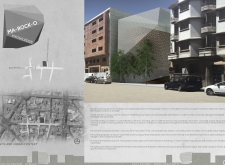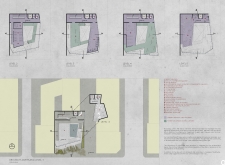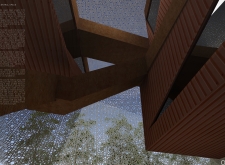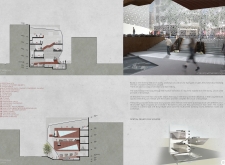5 key facts about this project
At the heart of the project lies a commitment to sustainability and responsiveness to its surroundings. By incorporating natural elements into the architectural framework, the design fosters a connection between the built environment and the landscape. The use of materials such as locally sourced stone, timber, glass, and metal not only emphasizes durability and maintenance but also resonates with the surrounding natural features, promoting a sense of continuity between inside and outside spaces.
The project's spatial organization is carefully refined, offering a clear articulation of functions that enhance user experience. The open layout allows for flexible use of spaces, accommodating various activities while ensuring a seamless flow throughout. This design choice facilitates social interaction and collaboration among users, reflecting modern lifestyle trends that favor communal engagement. The strategic placement of windows and skylights maximizes natural light infiltration, reducing reliance on artificial lighting and promoting energy efficiency aligned with sustainable design ideals.
Unique design approaches define the project’s character, with innovative features such as green roofs, rainwater harvesting systems, and solar panels integrated into the overall design. These elements not only reduce the ecological footprint of the building but also create opportunities for educational engagement, demonstrating sustainable practices to occupants and the community. Additionally, the incorporation of indoor gardens and biophilic design principles reflects a growing awareness of the psychological benefits of nature in architectural spaces, enhancing well-being and productivity.
Facade design serves as a critical element in the overall aesthetic narrative of the project. The interplay of textures and materials creates visual interest, while careful consideration of scale helps the building relate to its context. The use of shading devices and well-placed overhangs further contributes to the building's performance, allowing for passive temperature regulation, thus enhancing comfort for users. This emphasis on performance and contextual integration exemplifies the architectural principles guiding the project.
Another notable aspect is the attention paid to accessibility and inclusivity in the design. By ensuring that all spaces are navigable for individuals of varying abilities, the project underscores a commitment to universal design principles, promoting a sense of belonging. Pathways, entrances, and common areas are designed to be welcoming and functional, inviting all users to engage with the environment.
Details throughout the project reflect a meticulous approach to materials and finishes. The careful selection of non-toxic and sustainable materials speaks to a broader commitment to health and environmental integrity. This attention to the micro-level of design contributes to a cohesive aesthetic, creating an inviting atmosphere that encourages visitors to explore the space.
This architectural design project stands out for its thoughtful integration of sustainability, community, and aesthetic considerations, establishing a benchmark for future architectural pursuits. Its layers of meaning and intent encourage engagement and invite exploration, embodying a comprehensive vision of modern living. Readers interested in delving deeper into this project are encouraged to explore its architectural plans, architectural sections, architectural designs, and architectural ideas, which provide further insights into the innovative concepts that shape this endeavor.


























